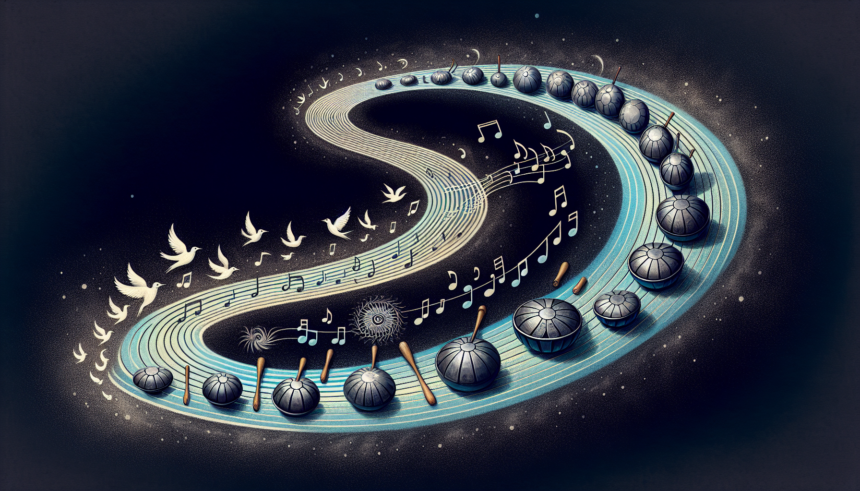The handpan, an ethereal percussion instrument known for its melodic and harmonic capacities, has revolutionized the music scene since its inception in the early 2000s. Its unique structure and sound capabilities have given rise to a distinctive genre of music that continues to evolve. This article explores the evolution of harmonic techniques in handpan music, tracing its journey from the basics to more advanced methods, and examines how musicians have continually pushed the boundaries of what this instrument can achieve.
The Birth of the Handpan
The handpan’s origins can be traced back to the Hang, created by PANArt in Switzerland in 2000. Inspired by traditional Caribbean steel drums, the Hang featured a unique shape and tuning system that allowed for a wide range of harmonic possibilities. Initially, the techniques employed were relatively straightforward, focusing on the novelty of the instrument’s design and sound.
Early Harmonic Techniques
In the early stages, handpan players primarily utilized basic striking techniques to produce melodies and harmonies. The instrument’s design, featuring a central note surrounded by a circle of other pitches, naturally lent itself to the creation of simple, meditative patterns. Players relied on the inherent tuning of the handpan to produce harmonious sounds with minimal effort.
Exploring Melodic Capabilities
As musicians became more familiar with the handpan, they began to explore its melodic capabilities more extensively. Techniques such as glissando (sliding between notes) and tremolo (rapidly alternating between notes) allowed for more complex and expressive playing. These techniques showcased the handpan’s ability to produce a rich tapestry of sound, further solidifying its place in modern music.
Introduction of Polyphonic Techniques
One of the significant advancements in handpan music was the integration of polyphonic techniques. This approach involved playing multiple notes simultaneously, creating a more intricate and layered sound. Musicians began experimenting with fingerpicking styles similar to those used in guitar playing, allowing them to produce chords and harmonies that were previously unachievable on the instrument.
Rhythmic Complexity and Harmonic Interplay
With the handpan’s capabilities expanding, musicians started incorporating more complex rhythmic patterns and harmonic interplay. Techniques such as ghost notes (subtle, almost imperceptible hits) and harmonics (notes produced by lightly touching the surface) became integral to creating dynamic and intricate pieces. These advancements not only showcased technical prowess but also highlighted the emotional depth the handpan could convey.
Integration with Other Instruments
Another significant milestone in the evolution of harmonic techniques in handpan music was its integration with other instruments. Collaborations with traditional and contemporary musicians opened up new avenues for exploration. By blending the handpan’s unique timbre with instruments like the violin, flute, or electronic synths, artists were able to create rich, multi-layered compositions that redefined the boundaries of handpan music.
Advanced Harmonic Techniques
In recent years, advanced harmonic techniques have continued to push the envelope of what the handpan can achieve. Musicians are now exploring less conventional methods such as using mallets or sticks instead of hands, which allows for different textures and dynamics. Additionally, the use of effects pedals and electronic modulation has introduced a new dimension to handpan music, blending traditional sounds with modern technology.
The Role of Technology in Harmonic Evolution
Technology has played a crucial role in the handpan’s evolution. Digital sound processing and recording techniques have enabled musicians to experiment with layering and manipulating sounds in ways that were not previously possible. This has resulted in the creation of complex harmonic landscapes that merge organic and electronic elements seamlessly.
Learning and Community
The growth of online communities and educational platforms has also contributed significantly to the advancement of harmonic techniques. Tutorials, workshops, and forums have democratized the learning process, allowing players from all over the world to share their knowledge and discoveries. This collective pool of information has accelerated the pace at which new techniques are developed and adopted.
Future Prospects
The evolution of harmonic techniques in handpan music is far from over. As new materials and manufacturing processes are explored, and as musicians continue to push the limits of their creativity, the handpan’s sonic possibilities will only expand further. The fusion of traditional and contemporary methods, coupled with technological advancements, promises a future where handpan music will continue to mesmerize and inspire.
Conclusion
The handpan’s journey from a novel percussion instrument to a cornerstone of modern harmonic music is a testament to the creativity and ingenuity of musicians worldwide. Through the continuous exploration of harmonic techniques, handpan music has evolved into a complex, emotionally resonant art form. As the instrument’s popularity grows, it is exciting to imagine the new heights of innovation and expression that lie ahead.
FAQs
1. What is the handpan?
The handpan is a melodic percussion instrument known for its unique design and sound. Originating from the Hang, created by PANArt in Switzerland in 2000, it features a central note surrounded by a circle of other pitches.
2. How has handpan music evolved over time?
Handpan music has evolved from simple striking techniques to incorporate complex melodies, polyphonic methods, rhythmic complexities, and advanced harmonic techniques. The integration with other instruments and the use of technology have further expanded its sonic capabilities.
3. What are some advanced harmonic techniques used in handpan music?
Advanced harmonic techniques include the use of mallets or sticks, electronic modulation, fingerpicking styles, ghost notes, harmonics, and the incorporation of effects pedals. These techniques enhance the instrument’s expressive potential.
4. How has technology influenced handpan music?
Technology has played a significant role in the evolution of handpan music by enabling digital sound processing, recording techniques, and electronic modulation. These advancements have allowed musicians to create complex harmonic landscapes that blend organic and electronic elements.
5. What is the future of handpan music?
The future of handpan music looks promising with the continuous development of new materials, manufacturing processes, and innovative techniques. The fusion of traditional and contemporary methods, along with technological advancements, promises to expand the handpan’s sonic possibilities further.





